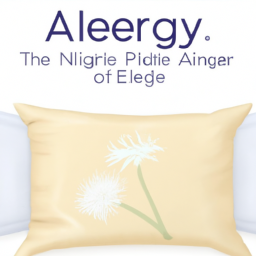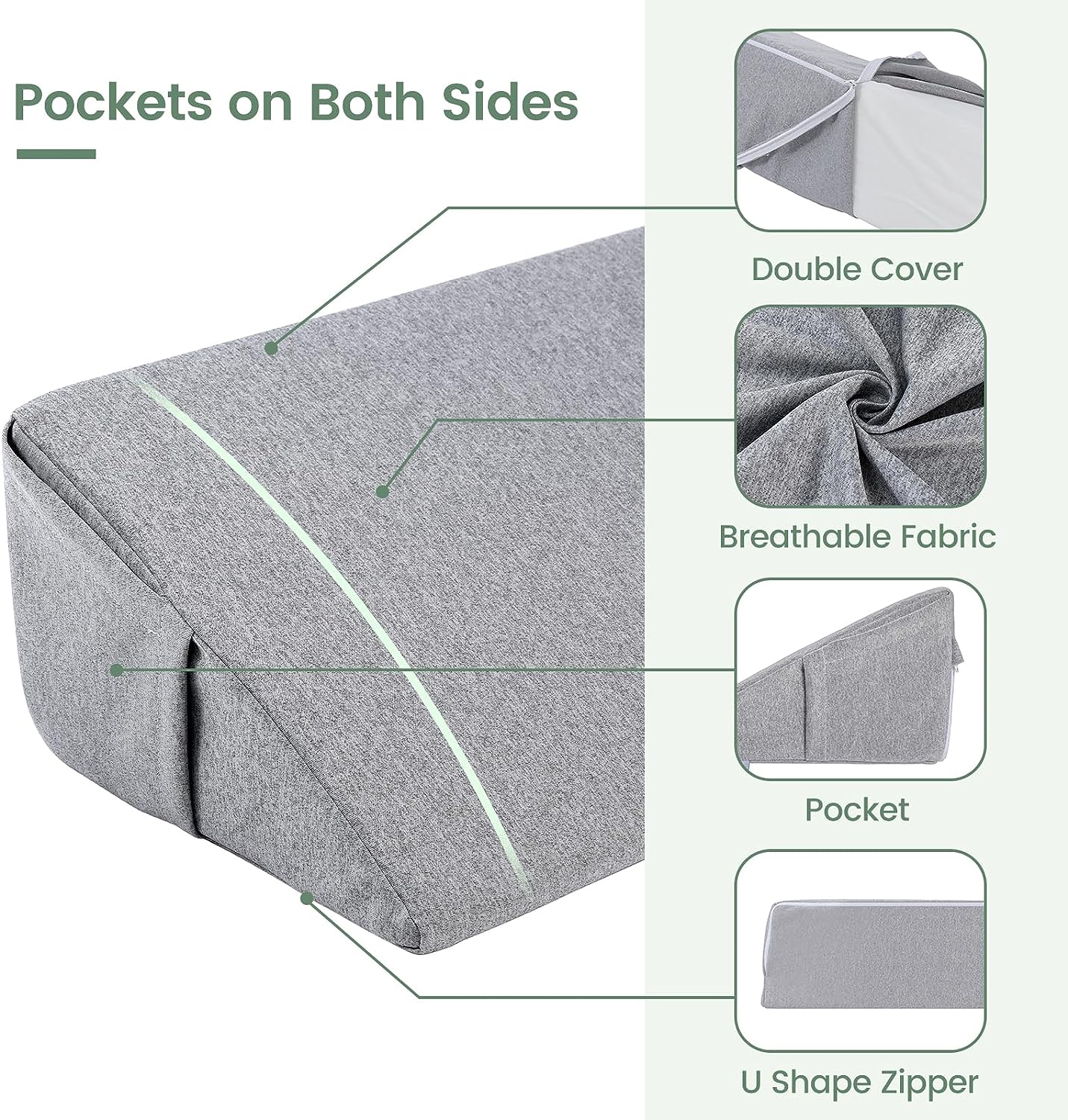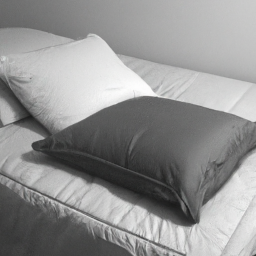Imagine a world where your mornings start with a refreshed and clear head, free from the shackles of nasal congestion. Picture yourself drifting off into a peaceful sleep, devoid of the annoying itchy throat and sneezing fits that often accompany nighttime allergies. While it may seem like a dream, the answer could be right under your nose – or rather, right beneath your head. That’s right, we’re talking about wedge pillows and their potential to alleviate the relentless symptoms of allergies.
In this article, we will explore the fascinating question: can using a wedge pillow help alleviate symptoms of allergies? We’ll delve into the most frequently asked questions surrounding these innovative pillows and provide you with a comprehensive understanding of their potential benefits. From exploring the science behind wedge pillows to discovering how they can improve your sleep quality, we will uncover the secrets behind this simple yet effective solution. So get ready to regain control over your allergies and embark on a journey towards a good night’s rest, all with the help of a trusty wedge pillow.
What is a wedge pillow?
Overview
A wedge pillow is a specialized pillow that is designed in the shape of a wedge, with a sloping angle that gradually elevates your upper body when you sleep. Unlike traditional pillows that are flat or rounded, wedge pillows offer a unique incline that can provide numerous benefits, particularly for those who suffer from allergies. These pillows are versatile and can be used for various purposes, including improving sleep quality, reducing acid reflux, alleviating respiratory issues, and relieving back and neck pain. In this article, we will explore the design, materials, and benefits of using a wedge pillow, specifically in the context of managing allergies.
Design and materials
Wedge pillows are typically made from high-quality foam or memory foam, which provides firm support and retains its shape over time. The incline of the pillow can vary, with some models offering a gradual slope while others have a steeper angle. The cover of the wedge pillow is usually removable and washable, allowing for easy maintenance and hygiene.
The shape of a wedge pillow is specifically designed to elevate your upper body, particularly the head, neck, and shoulders. The elevated position helps to keep your airways open and can reduce congestion and postnasal drip, which are common symptoms of allergies. Additionally, the incline can also prevent acid reflux by keeping stomach acid from flowing back into the esophagus, providing relief to those who suffer from both allergies and acid reflux.
Benefits of using a wedge pillow
Using a wedge pillow can provide several benefits for those who experience allergies:
-
Improved breathing: Allergies often cause nasal congestion and difficulty breathing. By elevating your upper body with a wedge pillow, you can open up your airways and promote easier breathing, allowing for a more restful sleep.
-
Reduced postnasal drip: Postnasal drip, where excess mucus drips down the back of the throat, can cause discomfort and disrupt sleep. The incline of a wedge pillow can help drain the sinuses and reduce postnasal drip, providing relief for allergy sufferers.
-
Alleviation of allergy symptoms: By reducing congestion, inflammation, and excessive mucus production, a wedge pillow can help alleviate symptoms such as sneezing, coughing, and itching associated with allergies.
-
Promotion of quality sleep: Allergies often disrupt sleep due to discomfort and difficulty breathing. With the use of a wedge pillow, you can experience improved sleep quality by minimizing allergy-induced disturbances and ensuring better airflow.
-
Enhanced recovery: Allergy-related symptoms can leave you feeling fatigued and drained. By using a wedge pillow, you can facilitate better rest and recovery, allowing your body to cope with allergies more effectively.
In the following sections, we will explore how allergies can affect sleep and the role of wedge pillows in managing allergies more comprehensively.
Understanding allergies
Types of allergies
Allergies can manifest in various forms, and individuals may have allergies to different substances. Common types of allergies include:
-
Seasonal allergies: Also known as hay fever or allergic rhinitis, these allergies occur during specific seasons when certain plants release pollen, such as spring or fall. Common triggers include tree pollen, grass pollen, and ragweed pollen.
-
Perennial allergies: Unlike seasonal allergies, perennial allergies can occur year-round. They are often caused by indoor allergens, including dust mites, pet dander, mold spores, and cockroach allergens.
-
Food allergies: Food allergies occur when the immune system reacts negatively to certain food proteins. Common food allergens include peanuts, tree nuts, dairy products, eggs, shellfish, and wheat.
-
Drug allergies: Some individuals may experience allergies to certain medications, often resulting in adverse reactions such as skin rashes, hives, or more severe symptoms like anaphylaxis.
Common allergy symptoms
Allergies can produce a wide range of symptoms, with severity varying from person to person. Common allergy symptoms include:
-
Sneezing: Allergies can trigger repeated sneezing, which is a way for the body to expel irritants or allergens.
-
Runny or stuffy nose: Nasal congestion, itchiness, and a runny or stuffy nose are common allergy symptoms. This is often caused by the body’s immune response to allergens.
-
Coughing and wheezing: Allergy-related coughing can be persistent and may be accompanied by wheezing or shortness of breath, particularly in individuals with respiratory conditions such as asthma.
-
Itchy, watery eyes: Allergies can cause redness, itching, and excessive tearing of the eyes.
-
Skin reactions: Skin reactions such as hives, rashes, or eczema may occur as a result of allergies, particularly food or drug allergies.
Causes of allergies
Allergies occur when the immune system mistakenly identifies a harmless substance (allergen) as a threat and initiates an immune response. This immune response leads to the release of chemicals such as histamine, which triggers the various allergy symptoms mentioned above. The exact causes of allergies are still not fully understood, but several factors may contribute to their development:
-
Genetics: Allergies can run in families, indicating a genetic predisposition to certain allergic conditions.
-
Environmental exposure: Prolonged exposure to allergens can increase the likelihood of developing allergies, particularly in susceptible individuals.
-
Overactive immune system: In some cases, an overactive immune system may be the underlying cause of allergies, where the immune response to allergens is exaggerated.
-
Allergic sensitization: Initial exposure to an allergen may sensitize the immune system, leading to subsequent allergic reactions upon re-exposure.
In the next section, we will explore how allergies can affect sleep and the potential consequences of poor sleep quality due to allergies.
How can allergies affect sleep?
Allergy-induced sleep disruptions
Allergies can have a significant impact on sleep quality, leading to disruptions and discomfort during the night. Some common ways allergies can affect sleep include:
-
Nasal congestion: Allergies often cause nasal congestion, making breathing through the nose difficult. This can lead to snoring, mouth breathing, and a higher likelihood of waking up during the night.
-
Disrupted sleep patterns: Allergy symptoms such as coughing, sneezing, itching, and congestion can interrupt sleep cycles, leading to frequent awakening throughout the night.
-
Increased sleep latency: Allergy-related discomfort can make it harder to fall asleep, resulting in longer sleep latency or the time it takes to fall asleep.
-
Restlessness and discomfort: Allergies can make individuals feel restless, constantly shifting positions in an attempt to find relief. This can lead to fragmented sleep and reduced sleep duration.
Impact on sleep quality and duration
The impact of allergies on sleep can result in reduced sleep quality and quantity. Continuous sleep disruptions and decreased sleep duration can have several negative effects on overall well-being, including:
-
Daytime fatigue: Poor quality sleep due to allergies can lead to daytime fatigue and excessive tiredness, making it challenging to concentrate, perform daily tasks, or engage in physical activities.
-
Decreased cognitive function: Lack of quality sleep can impair cognitive function, affecting memory, attention span, problem-solving, and decision-making abilities.
-
Mood disturbances: Sleep deprivation caused by allergies can contribute to mood swings, irritability, anxiety, and depression.
-
Compromised immune function: Sleep is essential for immune system function, and poor sleep due to allergies can weaken the body’s ability to fight off infections and illnesses.
In the following section, we will delve into the role of wedge pillows in managing allergies and improving sleep quality.
The role of wedge pillows in managing allergies
What is the connection between allergies and wedge pillows?
Wedge pillows can play a significant role in managing allergies by addressing the specific sleep-related challenges that individuals with allergies face. The elevated position provided by a wedge pillow can alleviate allergy symptoms and promote better sleep quality.
How does a wedge pillow work?
A wedge pillow works by elevating the upper body and keeping it at an inclined position during sleep. This elevation can help combat the effects of allergies in several ways:
-
Airway clearance: By keeping the head and neck elevated, a wedge pillow can help clear the airways, reducing congestion caused by allergies, such as postnasal drip and obstruction.
-
Reduced mucus production: The incline of a wedge pillow can minimize excessive mucus production, which is a common symptom of allergies. This, in turn, can alleviate coughing and throat irritation during sleep.
-
Acid reflux prevention: In addition to allergies, many individuals also experience acid reflux during sleep. The elevated position of a wedge pillow can help prevent acid from flowing back into the esophagus, reducing acid reflux symptoms and discomfort.
Benefits of using a wedge pillow for allergies
Using a wedge pillow specifically designed for managing allergies can offer numerous benefits, including:
-
Improved sleep quality: By alleviating allergy symptoms and ensuring better airflow, a wedge pillow can improve sleep quality, allowing for more restful and uninterrupted sleep.
-
Enhanced breathing: The elevation provided by a wedge pillow can help open up the airways, reducing nasal congestion and promoting easier breathing, especially for those with allergies or respiratory conditions.
-
Minimized congestion and postnasal drip: A wedge pillow can aid in draining the sinuses and reducing postnasal drip, reducing discomfort and irritation caused by congestion.
-
Alleviation of allergy-induced symptoms: The use of a wedge pillow can help reduce symptoms such as sneezing, coughing, itching, and watery eyes, providing relief to allergy sufferers during sleep.
In the next section, we will explore factors to consider when choosing the right wedge pillow for managing allergies.
Choosing the right wedge pillow
Factors to consider when selecting a wedge pillow
When choosing a wedge pillow for managing allergies, it is essential to consider the following factors:
-
Incline angle: The angle of incline can vary among wedge pillows. It is crucial to choose a pillow with an incline that provides optimal elevation for your specific needs and comfort.
-
Material and firmness: Consider the material and firmness of the pillow to ensure adequate support and comfort. Foam or memory foam pillows are popular choices due to their durability and ability to contour to the body’s shape.
-
Size and dimensions: Select a wedge pillow that suits your body size and fits well within your bed. It is important to choose a pillow that provides ample support for your upper body without feeling too narrow or wide.
Types of wedge pillows available
Various types of wedge pillows are available on the market, each designed to cater to different needs and preferences. Some common types of wedge pillows include:
-
Standard wedge pillow: These pillows feature a gradual incline and are suitable for individuals looking for mild elevation and basic support.
-
Folding wedge pillow: Folding wedge pillows offer flexibility and versatility. They can be adjusted to different incline angles, allowing users to customize their sleeping position and elevation.
-
Dual-position wedge pillow: Dual-position wedge pillows have a flat surface on one side and an incline on the other. This design allows users to switch between a flat and elevated position for different sleep preferences or health conditions.
Features to look for in a wedge pillow for allergies
To maximize the benefits of a wedge pillow for managing allergies, consider the following features:
-
Hypoallergenic materials: Opt for a wedge pillow that is made from hypoallergenic materials to minimize potential allergens and irritation.
-
Washable cover: Look for a wedge pillow with a removable and washable cover for ease of maintenance and hygiene.
-
Breathable design: Choose a pillow with a breathable design that allows for proper airflow, enhancing comfort and reducing the likelihood of heat buildup during sleep.
In the next section, we will delve into the effectiveness of wedge pillows in relieving allergy symptoms and explore research studies, testimonials, and expert opinions.
Effectiveness of wedge pillows in relieving allergy symptoms
Research studies and findings
Several research studies have explored the effectiveness of wedge pillows in addressing allergy symptoms and improving sleep quality. While further research is needed to establish these findings conclusively, existing studies indicate promising results.
One study published in The Journal of Allergy and Clinical Immunology found that using a wedge pillow significantly reduced nasal congestion and improved sleep quality in individuals with allergic rhinitis. Another study in the American Journal of Rhinology and Allergy reported that elevated sleep positions facilitated by wedge pillows reduced nasal congestion, cough frequency, and throat symptoms in sleep-related allergic rhinitis patients.
Testimonials and user experiences
Many individuals who suffer from allergies have reported positive experiences with using wedge pillows. Testimonials and user reviews often mention relief from congestion, reduced coughing, and overall improved sleep quality. Users appreciate the ergonomic design and the ability of a wedge pillow to alleviate allergy symptoms, allowing them to wake up feeling refreshed and rejuvenated.
Expert opinions on wedge pillows for allergies
Healthcare professionals and sleep experts have also weighed in on the effectiveness of wedge pillows for managing allergies. Many experts recommend the use of wedge pillows as part of a comprehensive approach to allergy management, particularly during sleep. They emphasize the importance of elevating the head and upper body to reduce congestion, ease breathing, and alleviate discomfort caused by allergies.
In the following section, we will explore other measures that can be combined with wedge pillows for better results in alleviating allergy symptoms.
Other measures to alleviate allergy symptoms
Combined approaches for better results
While the use of a wedge pillow can be effective in managing allergies, combining it with other measures can enhance its results. Some strategies to consider include:
-
Allergen avoidance: Identify and minimize exposure to common allergens such as dust mites, pollen, pet dander, and mold by keeping living spaces clean, using air purifiers, and washing bedding regularly.
-
Maintaining good sleep hygiene: Practice good sleep habits, including a consistent sleep schedule, creating a comfortable sleep environment, and avoiding stimulants like caffeine and electronics before bedtime.
-
Nasal irrigation: Nasal irrigation using saline solutions or neti pots can help clear nasal passages, reduce congestion, and alleviate allergy symptoms.
-
Allergy medications: Consult with a healthcare professional to identify appropriate allergy medications or nasal sprays that can help manage symptoms.
Tips for managing allergies
In addition to specific measures mentioned above, here are some general tips for managing allergies:
-
Stay informed: Educate yourself about the specific allergens that trigger your symptoms and take appropriate steps to avoid or minimize exposure.
-
Keep your environment clean: Regularly clean and vacuum your living and sleeping areas to reduce the presence of allergens like dust mites and pet dander.
-
Wear protective gear: When doing outdoor activities, wear sunglasses, hats, and face masks to minimize exposure to allergens.
-
Monitor pollen levels: Stay updated on daily pollen counts and adjust your plans accordingly to minimize exposure during peak pollen seasons.
Professional medical advice
It is important to consult with a healthcare professional, such as an allergist or immunologist, for personalized advice and guidance. They can help identify specific allergens, recommend appropriate treatment options, and provide further insight on incorporating a wedge pillow into your allergy management plan.
In the next section, we will discuss some precautions and considerations when using wedge pillows for managing allergies.
Precautions and considerations
Precautions to take when using wedge pillows
While wedge pillows can be beneficial for managing allergies, it is essential to take certain precautions:
-
Proper positioning: Ensure that the wedge pillow is positioned correctly and provides adequate support for your upper body. Improper alignment or use of the wrong pillow size could lead to discomfort or exacerbation of existing conditions.
-
Monitor individual comfort: Every individual is different, and what works for one person may not work for another. Pay attention to your comfort level and adjust the pillow height and incline as needed.
-
Trial period: If you are new to using a wedge pillow, consider starting with a trial period to see if it suits your sleep needs and alleviates your allergies effectively.
Consultation with a healthcare professional
Individuals with underlying health conditions or chronic allergies should consult with a healthcare professional before using a wedge pillow. They can provide personalized recommendations and ensure that using a wedge pillow aligns with your overall health and allergy management plan.
Allergies and individual differences
Allergies can vary significantly among individuals, and what works for one person may not work for another. It is essential to recognize and respect individual differences when managing allergies, including the use of wedge pillows. Some individuals may find greater relief from combining multiple strategies, while others may experience significant improvement solely from using a wedge pillow.
In the concluding section, we will summarize the benefits of using a wedge pillow for allergies and provide final thoughts.
Conclusion
Summary of the benefits of using a wedge pillow
Using a wedge pillow can provide several benefits for individuals with allergies, including improved sleep quality, enhanced breathing, minimized congestion and postnasal drip, and alleviation of allergy-induced symptoms. The inclined position of a wedge pillow facilitates proper airway clearance, reduces mucus production, and prevents acid reflux, contributing to a more comfortable and restful sleep experience.
Final thoughts
If you suffer from allergies and are experiencing sleep disruptions or discomfort, incorporating a wedge pillow into your sleep routine can be a valuable addition. However, it is important to remember that wedge pillows are not a sole solution. Combined with other allergy management strategies, such as allergen avoidance, good sleep hygiene, and appropriate allergy medications, they can significantly improve your sleep quality and alleviate allergy symptoms. Consult with a healthcare professional to ensure that using a wedge pillow aligns with your individual needs and health conditions. With the right approach, you can enjoy a night of peaceful sleep and wake up feeling refreshed, even in the midst of allergies.







